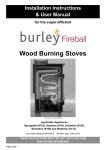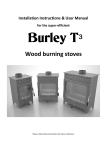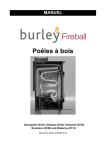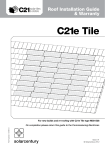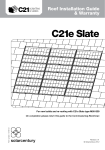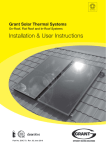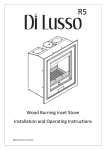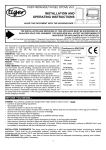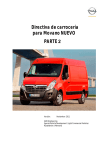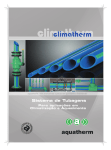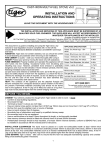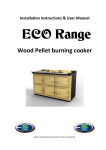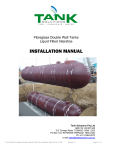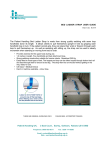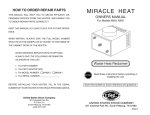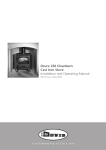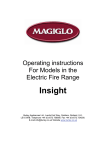Download Installation Instructions & User Manual
Transcript
Installation Instructions & User Manual for the super-efficient Wood Burning Stoves Cross Section – Artist Impression Applicable Appliances Springdale (9103), Debdale (9104), Hollywell (9105), Brampton (9108) and Wakerley (9112) Document reference BUR/12/13 Revision date: DECEMBER 2013 THESE INSTRUCTIONS MUST BE LEFT WITH THE USER FOR FUTURE REFERENCE Thank You Thank you for purchasing a Burley Fireball Wood Burning Stove; we hope you will be delighted with the super-efficient performance. Included with your stove is the Burley ‘Thank You Kit’, which typically contains:- A Spanner to attach and adjust the tension of the air control lever A Coaster to protect the top of your stove Four Hearth Protectors to place under the stove legs A Moisture Meter to ensure your wood is dry Glass Cleaner Stove Paint in case you prefer black handles or ever need to touch up any paint work A Heat Resistant Glove Scoop for removing ash An Allen Key should you wish to adjust the door handle A Mug to enjoy a cup of tea whilst admiring the fantastic flame picture The contents of the kits vary from model to model, so not all the items listed or shown above may be included with your stove. Page 2 of 20 Features… You now own the world’s most efficient stove Page 3 of 20 Table of Contents Technical Data.............................................................................................................................. 6 Stove Dimensions and Room Sealing Options ......................................................................... 7 Approvals ..................................................................................................................................... 8 Levers and Handles ..................................................................................................................... 8 Hearths.......................................................................................................................................... 8 Surrounds ..................................................................................................................................... 9 Air Supply and Room Sealing Kit ............................................................................................... 9 Optional Convection Tube Cover Plate .................................................................................... 10 Door Handle Adjustment ........................................................................................................... 10 Chimneys and Flues .................................................................................................................. 11 Stove Assembly ......................................................................................................................... 11 Air Lever Assembly ................................................................................................................... 12 Door Handle Assembly .............................................................................................................. 13 Assembly and Installation of the Stove Fire Bricks ................................................................ 14 Fitting of Stove Bricks ............................................................................................................... 14 Fitting the Stainless Steel Baffle Plate ..................................................................................... 14 Flue Pipe ..................................................................................................................................... 15 Log Retaining Bar ...................................................................................................................... 15 Commissioning the Appliance .................................................................................................. 15 Using the Moisture Meter .......................................................................................................... 15 USER INSTRUCTIONS ............................................................................................................... 16 To Light the Stove: .................................................................................................................... 16 Poor Appliance Operation and Troubleshooting: ................................................................... 16 Care of Glass .............................................................................................................................. 17 Chimney Sweeping and Maintenance ...................................................................................... 18 Safety .......................................................................................................................................... 18 Warranty ..................................................................................................................................... 19 Reasons for Premature Wear of Internal Parts........................................................................ 19 If you need further help ............................................................................................................. 19 Customer and Installation Notes .............................................................................................. 20 Page 4 of 20 WARNING The Burley Fireball series of stoves are primarily for burning wood (this includes logs and sawdust briquettes). In smoke control areas only wood fuels should be used. Before purchasing a stove we would strongly advise you seek the advice of a HETAS installer to ensure suitability of the product to your home. Other fuels, such as coal (any type), smokeless fuels or petroleum coke can only be used if the optional multi-fuel grate is fitted (available on models 9104 and 9105 only). Under no circumstances should liquid fuels be added. It is not an incinerator and rubbish, including painted or tanalised wood and MDF, should not be burnt in this appliance, doing so is potentially dangerous and will invalidate any guarantees immediately. Installation Instructions When installing these appliances, all local regulations, including those referring to national and European Standards need to be complied with. This manual covers the appliances: Burley Models: 9103, 9104, 9105, 9108 and 9112 The nominal space heating output is: ‘Springdale’ 9103: 3Kw ‘Debdale’ 9104: 4Kw ‘Hollywell’ 9105: 5Kw ‘Brampton’ 9108: 8Kw ‘Wakerley’ 9112: 12Kw Any of the above appliances must be installed by an installer registered with a competency scheme (ie HETAS/ELECSA England & Wales), conforming to Building Regulations PtJ and the installation must be registered with the local council building control department. Failure to comply with the above renders all guarantees and liabilities of the manufacturer null and void. By carefully following the instructions below we are certain that you will enjoy many years of warmth and enjoyment from your new Burley Fireball Stove. The manufacturer will not guarantee or accept liability for any problem that arises unless a local authority building control certificate has been completed and a valid receipt or proof of purchase is presented from the approved supplier. The appliances should not be fitted closer to combustible materials, e.g. wooden fire surround or stud wall, than is shown in the table on page 6. When fitted against a wall made of combustible material e.g. a wooden stud wall with plasterboard, unless a 75mm thick non-combustible material is used as a barrier, extra noncombustible material should be fitted behind the stove if the distance from the wall is less than shown. When fitted inside a masonry or similar non-flammable material recess, e.g., fireplace opening, there is no minimum distance; although we would advise a minimum of 50mm from any surface to allow for convection. Page 5 of 20 Technical Data All built to EN13240 Springdale 9103 Debdale 9104 Hollywell 9105 Brampton 9108 Wakerley 9112 Efficiency (Net) 88.9% 89.8% 89.1% 85.5% 84.1% CO concentration @ 13% Oxygen 0.1% 0.1% 0.1% 0.1% 0.1% Dry logs <20% H₂O Dry logs <20% H₂O Dry logs <20% H₂O Dry logs<20% H₂O Dry logs<20% H₂O Maximum length 170 -220mm long Maximum length 200 -250mm long Maximum length 250 -300mm long Maximum length 250 -350mm lonG Maximum length 300 -450mm long Maximum width 150mm Maximum width 150mm Maximum width 150mm Maximum width 150mm Maximum width 150mm Dry Logs < 25% H₂O Dry Logs < 25% H₂O Dry Logs < 25% H₂O Dry Logs < 25% H₂O Dry Logs < 25% H₂O 220mm long 250mm long 310mm long 430mm long 580mm long 45 kg 57 kg 95 kg 105 kg 130 kg 3kw 4kw 5kw 8kw 12kw 1,962mm sq min 50mm diameter 7,850mm sq min 100mm diameter Not Required 550mm sq min in houses built after 2010, otherwise not required Air vent not required if stove is room sealed Air vent not required if stove is room sealed Air vent not required if stove is room sealed Requirement of fuels used in smoke control areas Lower quality fuel can be used in non-smoke controlled areas, but will not give the best efficiencies Weight in kg Nominal KW output Air vent requirement. Not Required Minimum flue draught mm H²O 0.5mm 0.5mm 0.5mm 0.5mm 0.5mm Flue gas temperature 162 °C 156 °C 122 °C 183 ˚C 237 °C Spigot Temp. 258 °C 253 °C 241 °C 274 °C 316 °C Flue size (Top Exit) 127mm (5”) 127mm (5”) 150mm (6”) 150mm (6”) 150mm (6”) Min. chimney diameter 127mm (5”) 127mm (5”) 150mm (6”) 150mm (6”) 150mm (6”) Best chimney diameter 127mm (5”) 127mm (5”) 150mm (6”) 150mm (6”) 175mm (7”) 20cm behind (8”) 35cm at side (14”) 35cm to Top 20cm behind (8”) 40cm at side (14.5”) 40cm to Top 20cm behind (8”) 35cm at side (14”) 35cm to Top 20cm behind (8”) 40cm at side (16”) 40cm to Top 20cm behind (8”) 45cm at side (18”) 45cm to Top <100 °C <100 °C <100 °C <100 °C <100 °C 12mm 12mm 12mm 12mm 12mm Minimum distance to combustible materials All other distance as per Building regulations Part J or HETAS recommendations Max Hearth temp. Min Hearth thickness Page 6 of 20 Stove Dimensions and Room Sealing Options Page 7 of 20 Approvals All our wood stoves are approved to EN13240:2001 and EN13240 A2:2004. DEFRA Approval The 9103, 9104, 9105 and 9108 models have been approved by DEFRA for use in smokeless areas. They have been designed and tested with a special air plate (see below). The plate restricts the air at high rate, but allows air into the stove when shut down to reduce the potential for producing smoke. Due to its huge heat ouput, the 9112 has not been submitted for DEFA approval. Web site: http://smokecontrol.defra.gov.uk/appliances.php?country=e Aeration hole must be left open for use in smokeless areas. Aeration hole can be closed, if not used in smokeless areas. Levers and Handles Please ensure that all levers and handles move correctly prior to positioning the stove in the opening or on the hearth. Adjustment may prove difficult once the stove is positioned. Hearths The stove must stand on a non-combustible surface. Installation standards dictate that hearths must be at least 12mm thick, but installers must take into account the weight of the stove on such thin material. The hearth should extend a minimum of 225mm in front of the stove. When a stove is freestanding the hearth should always extend a minimum of 150mm either side of the stove. Page 8 of 20 Strength and heat resistance of the hearth. Stoves are very heavy and most materials used for hearths crack very easily. It is impossible for Burley to inspect each hearth or comment on every installation, so the onus is on the installer to ensure the construction of the hearth is suitable for the application. Slate hearths can be particularly fragile. If in any doubt we recommend sliding a piece of vermiculite or calcium silicate insulation beneath the stove to protect it from the heat. As guidance however: Do not use boxed and lipped hearths. Avoid marble, conglomerate or micro marble hearths. Rather than using one large piece of material, use sectional hearths or slabs which will move independently and allow for expansion due to heat. Should a slab section crack it is then easier and cheaper to replace. Bed hearths down on a level base, not directly on a hard surface which could be uneven. If necessary stand the stove on a steel or stone bed to ensure the weight is distributed. Do not subject the hearth to sudden impacts by dropping the stove. The stove is heavy and it is strongly recommended that lifting is undertaken by two people. Use the hearth protection squares. Surrounds Must be capable of withstanding the temperature produced by the stove and comply with the minimum distances to combustibles. Air Supply and Room Sealing Kit All hydrocarbon burning appliances require an oxygen/air supply. If the stove is to be fitted on an external wall the air supply can be taken straight from the outside by using the room sealing kit. A 100mm diameter hole needs to be drilled in the correct place (138mm above the hearth) to take the 86mm external (80mm internal) duct as supplied. This will allow for easy connection. Any gap can be filled in with cement or mastic. A proprietary grille is supplied with the kit. A room sealing kit which exits horizontally is available. The room sealing method of supplying air is always to be preferred as heat loss from the room will be greatly reduced. If the stove is not on an outside wall or the room sealing kit cannot be used, an air vent must be supplied in the room in which the stove is fitted. The sizes of the vents required are: 3Kw – No vent required 4Kw - No vent required 5Kw – For homes built before 2010 – no vent required. For homes built after 2010 - 550mm sq 8Kw - 1650mm sq (50mm diameter) 12Kw 4950mm Sq (100mm diameter) Page 9 of 20 Only permanently open vents can be used and consideration should be given to draught when the stove is not in use, therefore site this vent carefully. The vent covers should comply with Building Regulations Part J and should be sited where they cannot be blocked. Optional Convection Tube Cover Plate The cover plate is an option for those people who do not like the appearance of the convection tubes. Fitting the cover plate is easy: (1) Offer the cover plate up to the stove and locate the clips on the rear into the tubes and push it on. (2.) Make sure it is fitted open at the top and flush at the bottom. This is important for the convection heat to come through the tubes. Fitting the cover plate will not affect the efficiency of the stove. Open at the top. Flush at the bottom. 1. 2. Door Handle Adjustment There is a CAM and LOBE mechanism so that the door can be tightened against the glass seal. The door may require adjustment as the rope seal compresses. A 5mm Allen key will be required. . To adjust the door, loosen off the socket screw and turn the off centre cam to move the door in or out, up or down. Tighten screw after adjustment. Page 10 of 20 Chimneys and Flues The 9103 and 9104 require a minimum chimney flue of 5” (125mm), 9105, 9108 and 9112 models require a minimum chimney flue of 6” diameter (150mm). All chimneys/flues must be a minimum length of 4 metres and must comply with Building Regulations J. Never share the flue with another appliance. If flue and chimney are not to these specifications there could be insufficient draw to pull oxygen through the appliance to make it burn properly. Due to the low temperature of the exiting flue gases we recommend that the flue is lined. If you live in a valley or are surrounded by tall trees or buildings you might experience downdraught problems where the wind tries to stop the fumes rising up the chimney. An antidowndraught cowl might help, but anti-downdraught cowls reduce the draw. We recommend you seek the advice of a HETAS (0845 634 5626) or NACE (01526 322 555) registered supplier and installer before purchasing any stove or heating appliance. Stove Assembly Using the Allen key provided, remove the socket screw on the door and lift off the transit bracket. Keep the socket screw and Allen key safe as you will need this for assembling the door handle. Unpack the contents of the stove. Page 11 of 20 Air Lever Assembly Tilt the stove back on the rear legs and support it so you can access the underneath of the stove (A). Push the air lever through the slot in the front of the stove, locate the end of the lever over the air plate bar and threaded stud. Assemble the washers and nut as per diagram (B) using the 13mm spanner. Please ensure the lever moves from left to right with just a little resistance to ensure it stays in place. Page 12 of 20 Door Handle Assembly Fit the door handle and parts as per the assembly diagram below. (Please note it is very important to fit the parts in the correct sequence). Tighten up the socket screw using the Allen key provided in the ‘thank you’ kit. Page 13 of 20 Assembly and Installation of the Stove Fire Bricks Having positioned your Burley stove and connected it to a chimney with flue pipe, you need to assemble the inside parts. There are five internal components: top brick, two side cheeks, a rear brick and a stainless steel baffle. Fitting of Stove Bricks To fit the vermiculite bricks: Place the left side in so the longer edge is at the front and the shorter edge at the rear. Put the top brick in the stove so the rounded edges are at the back and the flat surface is up. The top brick should stay in place by resting it on the side brick and the top of the square metal tubes. Place the right side in so the longer edge is at the front Place the back in. Slide the top brick backwards so the lip sits over the back and side bricks, keeping them in place and ensuring there is no gap at the back. The base brick should already be fitted. Fitting the Stainless Steel Baffle Plate Fit the plate by putting the legs of the plate on top of the rear square metal tubes, you may need to lift the top brick. Bring the plate forward so it sits on the ledge above the door. Check that the top brick is still at the back of the stove and has not moved forward. When sweeping the chimney or carrying out regular maintenance on the stove, reverse the above procedure, clean the chimney and the top surface of the top baffle and the stainless steel mesh, then reposition all the components. Page 14 of 20 Flue Pipe We recommend 1mm stainless steel pipe sprayed matt black. Only use vitreous enamel pipe if it is stainless steel. Log Retaining Bar Fit the log retaining bar so the angled return is pointing into the stove. This will help to keep the glass clean. Commissioning the Appliance On completion of the installation, when any fire cement or paint used has dried, a smoke ‘bomb’ should be burnt and all joints checked for smoke leakage and the chimney draw checked with all doors and windows closed. Please leave the instructions with the customer and inform them;The first time the stove is lit only a small fire should be used to allow the paint to cure properly. Ventilate the room well as the fumes can be pungent. Use a small amount of kindling to start the fire. If possible leave the door on the catch, although the fire looks fierce it is comparatively cool due to all the air being drawn in. Add a little more kindling as it burns down. When you have a small bed of embers place a small split log in the fire, allow it to catch well, and then close the door with the lever to the right. Stay with the fire during this process. When this first log is burning down add another log, when this one is burning well you should be able to move the lever midway to the centre. Keep feeding the stove for three hours with a small split log as it burns low. When you need to remove some ash wait until it is cold and then take some out using the scoop provided. Always leave an inch of ash so you have a nice bed for your next fire. Using the Moisture Meter For the stove to operate at maximum efficiency the wood should be as dry as possible, certainly below 18%. Burning damp or wet wood will not only stop the stove working efficiently, but also create excess smoke and stain the glass. Remove the plastic cap covering the two contact pins. The pins are sharp for a reason, so please use it carefully. Push the pins into the inner surface of the split log (5mm as a guide) this will give an accurate reading. Simply putting the contact pins onto the surface will not give an accurate reading, as it may tell you that the surface is dry whilst the interior of the log may well be damp. Page 15 of 20 USER INSTRUCTIONS To Light the Stove: It is important to keep an approximate minimum depth of ¾” (20mm) of wood ash in the fire box at any time. You will achieve this after the first few firings. Place 1 or 2 firelighters in the bottom, then add some kindling wood criss-crossed, and finally a small log on top. Light the firelighters, open the air vent to maximum (to the right) and close the door to the first latch so there is an air gap around it. Leave it like this for around five minutes or so, the fire should be well alight and the door can now be closed to become air tight. Leave the air control lever to the right for a further 10 to 20 minutes to get the stove completely up to running temperature. If the stove does goes out when the door is closed then the flue is still too cold and will not pull, in this case you may need to leave the door open with kindling burning for longer. The flue’s pull will change dependant on temperature and atmospheric conditions. The best lever position to achieve maximum efficiency will depend on the chimney draw, but will normally be near the centre. Every chimney is different, and you will eventually find your stove’s optimum position. This is when the flames are swirling in a lazy manner around the stove, not roaring. If the lever is pushed too far to the left, you starve the fire of oxygen, causing the glass to darken. Move the lever a small amount to the right until the glass just stays clean. The best way to run any wood stove is ‘little and often’. If you are with the fire, it is best to keep adding a small log every 45 minutes rather than adding large ones every 2 hours. THE STOVE IS NOT DESIGNED TO BE USED WITH THE DOOR OPEN! To reload, open the door slowly to allow the pressure to equalise. Using the glove provided, place the fresh log towards the rear of the appliance. Close the door. Do not load the stove with wood and close the damper down, this produces lots of creosote. Poor Appliance Operation and Troubleshooting: Refuelling onto a low fire bed If there is insufficient burning material in the fire bed to light a new fuel charge, excessive smoke emission can occur. Refuelling must be carried out onto a sufficient quantity of glowing embers and ash to ensure that the new fuel charge will ignite. If the fuel bed is too low or cool, suitable kindling must be used to re-light fires. Page 16 of 20 Overloading the fire bed The maximum amount of fuel specified in this manual should not be exceeded. The weight of dry wood per hour is: 1.3kg for the 9103, 1.8kg for the 9104, 2.2kg for the 9105, 3.5kg for the 9108 and 5.25kg for the 9112. Overloading can damage components of the stove. Leaving door open Operation with the door open can cause excess smoke and a potential fire hazard. The appliance must not be operated with the door left open except as directed in the instructions. Air damper left fully open Although the fire will look impressive, you will be burning more wood for less heat. The glass can also be damaged. Substantial Smoke Emission If substantial smoke emission is observed from the appliance at any time during the operation of the appliance the operator should ensure they are following the operation instructions and using suitable fuel. The flue may not be pulling as it is too cold or incorrectly specified/installed. Check that the top brick is at the back of the fire. Door Adjustment The locking mechanism on the door is made up of a cam and lobe assembly. The door can be loosened or tightened with an Allen key (see page 11). The door will need to be adjusted over time as the rope seal compresses. Care of Glass The first few firings will cure the paint and we recommend that you clean the glass after this has happened. This will ensure that there are no contaminates on the glass to attract further staining. A ceramic glass cleaner should be used to clean the glass. Do not allow marks to build up without cleaning. The stove is double glazed; check the rope seals and screws regularly to ensure a long life. Do not use with broken glass. Over tightening of the glass clips could cause the internal glass to crack. Only clean the glass when it is cold. Page 17 of 20 Chimney Sweeping and Maintenance It may be wise to contact your local chimney sweep before the stove is installed. Your chimney should be swept at least once a year by a registered sweep, twice a year with heavy use. The sweep should also replace the fire cement at the base of the flue if necessary. The chimney can be swept through the stove. The stainless steel baffle and top brick should be removed in the reverse order described on page 14. The baffle should be cleaned at least twice a year with heavy use, checked, renewed as required and replaced. Unless advised by Burley the stove should not be used with any baffle missing. All rope and glass seals should be checked annually and replaced as necessary. If the stove has not been used for a prolonged period, in excess of 6 months, the chimney should be swept prior to use to check for blockages, birds’ nests etc. and rubble/debris blocking the flue ways. Safety NOTE: As with all solid fuel appliances, a carbon monoxide detector should be purchased for use in the room. All solid fuel appliances produce considerably more Carbon Monoxide in normal use than oil or gas appliances, but the general ‘smell’ of the smoke or exhaust is much stronger and more easily detected by a healthy person. Always use your appliance with the door shut and look for tell-tale signs of excessive leakage: smoke stains above the fireplace, smoke emitting around the door when running, strong smell of soot upstairs etc. Check the seals at the joints annually and replace the fire cement as required. Check especially the joint of the flue pipe to the chimney register plate, hairline cracks are OK, but lumps of cement missing produce a bad joint. A proprietary jointing compound should be used here, as it is far superior to a cement and rope seal. Never block air vents either internally or externally. Use the supplied glove to reload the stove. In the event of a chimney fire, close the door and shut the air vent right down. If possible throw ½ cup of course table salt onto the fire. Never modify parts or fit parts to the appliance that are not recommended by the manufacturer. Never use this appliance in the same flue as another appliance. The surface of a wood burning stove gets extremely hot in normal use. When using the stove in situations where children or aged and/or infirm persons are present, a fireguard must be used to prevent accidental contact with the stove. The fireguard should be manufactured in accordance with BS 8423:2002. Page 18 of 20 Warranty All our stoves are covered by a five year metalwork warranty. (This is subject to the correct fuel having been used and not overloading the stove.) The five year warranty covers the stove body only and does not include consumable items such as grates, firebricks, vermiculite panels, baffles, log guards, door rope and glass. Any warranty claims should be addressed to your original supplier and accompanied with the date of purchase and serial number of the appliance. Reasons for Premature Wear of Internal Parts Stove being used/fired too vigorously Too little air passing through the stove Use of excessively dry wood (wood from old furniture) Excessive debris collection on baffle plate or inner fireback (see section on cleaning) Ash level too high in the ash pan If you need further help If you need further help with your Burley Stove then the first point of contact should be your HETAS installer, who will be able to provide the answers to most questions. Your Burley retailer also has a great deal of experience and will also be able to provide helpful advice. Further help is available from Burley’s Customer Services department who will be pleased to give advice, if necessary. Page 19 of 20 Customer & Installation Notes Date of Installation: HETAS Installer Name & contact details Chimney Swept Date Notes: Made in the UK Burley Appliances Limited Lands End Way Oakham Rutland LE15 6RB United Kingdom Further information can be found at: burley.co.uk/woodburner.php Email: [email protected] Phone: 01572 756956 Fax: 01572 724390 Page 20 of 20




















